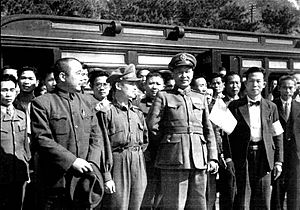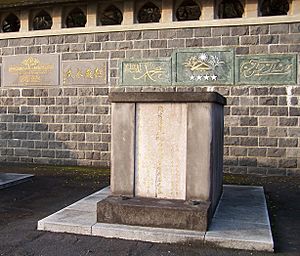Bai Chongxi facts for kids
Quick facts for kids
Bai Chongxi
|
|
|---|---|
| 白崇禧 | |
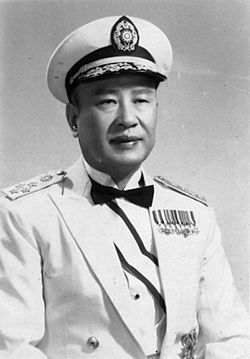 |
|
| 1st Minister of National Defense of the Republic of China | |
| In office 23 May 1946 – 2 June 1948 |
|
| Preceded by | Chen Cheng as Minister of War |
| Succeeded by | He Yingqin |
| Personal details | |
| Born | 18 March 1893 Guilin, Guangxi, Qing Empire |
| Died | 2 December 1966 (aged 73) Taipei, Taiwan |
| Political party | Kuomintang |
| Spouse | Ma P'ei-chang |
| Children | 10, including Kenneth |
| Alma mater | Guangxi Military Cadre Training School Baoding Military Academy |
| Awards | Order of Blue Sky and White Sun Legion of Merit |
| Nicknames | The Wise Man, Little Zhuge |
| Military service | |
| Allegiance | |
| Branch/service | New Army National Revolutionary Army |
| Years of service | 1907–1949 |
| Rank | General |
| Unit | New Guangxi Clique |
| Commands | Minister Of National Defense, Central China Pacification Director |
| Battles/wars |
|
Bai Chongxi (born March 18, 1893 – died December 2, 1966) was a very important Chinese general. He served in the National Revolutionary Army of the Republic of China. He was also a leading figure in the Chinese Nationalist party.
Contents
Early Life and Rise to Power
Bai Chongxi was born in Guilin, China. His family were descendants of a Persian merchant. At 14, he started studying at a military school in Guilin. He later joined the Baoding Military Academy.
Bai became famous during a time called the warlord era. This was when different military leaders controlled parts of China. Bai teamed up with two friends, Huang Shaohong and Li Zongren. Together, they formed the New Guangxi Clique.
This group helped bring their home province, Guangxi, under the control of the Republic of China. Bai and Li became new leaders in the region.
The Northern Expedition
Bai Chongxi played a big role in the Northern Expedition. This was a military campaign to unite China under one government. Bai was the Chief of Staff for the army. He was known for using smart tactics like speed and surprise.
He led troops that took over important cities like Hangzhou and Shanghai. He was also one of the first commanders to enter Beijing. Because of his clever strategies, people called him Xiao Zhuge. This means "little Zhuge Liang", after a famous ancient Chinese strategist.
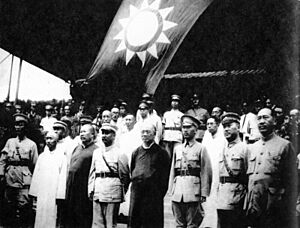
In 1928, Bai's forces defeated General Zhang Zongchang. He captured many of Zhang's soldiers. After the Northern Expedition, Bai helped rebuild Guangxi province. It became a very well-run "model" province. Guangxi later sent many soldiers to fight against Japan.
Fighting in the Sino-Japanese War
In 1937, a major war started between China and Japan. This was the Second Sino-Japanese War. Bai Chongxi was invited by Chiang Kai-shek, China's leader, to rejoin the government. Bai became the Deputy Chief of the General Staff. He was in charge of planning military operations and training.
Bai was a key strategist during the war. He convinced Chiang Kai-shek to use a "Total War" strategy. This meant trading land for time and using guerrilla tactics. Chinese forces would destroy supplies in areas the Japanese were advancing into. This stopped the Japanese from getting local resources.
Bai was involved in many important battles. He helped win the Battle of Tai'erzhuang in 1938. This was a big victory against a stronger enemy. He also oversaw the successful defense of Changsha three times. The Japanese attacked Changsha between 1939 and 1942 but were always pushed back.
Bai's soldiers from Guangxi were known as an "elite" army. Many people believed he was a very capable general. He was even considered a possible successor to Chiang Kai-shek. Bai also worked to unite Chinese Muslims and Han Chinese against Japan. He traveled to Muslim areas to counter Japanese messages. In 1945, he received an award from the United States.
Role in the Chinese Civil War
After Japan surrendered in 1945, the Chinese Civil War began again. This was a fight between the Nationalist government and the Communists. In 1946, Communist forces took control of a key railroad junction in Siping. Nationalist forces struggled to remove them. Chiang Kai-shek sent Bai Chongxi to help.
Bai reorganized the Nationalist forces. They then defeated the Communist army in a major battle. This was an important victory for the Nationalists early in the Civil War.
In June 1946, Bai became the Minister of National Defense. However, he found that he didn't have much real power. Chiang Kai-shek often made military decisions without him. As the war continued, the Nationalists began to lose ground.
By 1949, the Communists were close to winning. Many Nationalist leaders wanted to negotiate for peace. Bai Chongxi also asked Chiang Kai-shek to step down as president. He wanted the government to negotiate with the Communists.
When Communist forces attacked Bai's troops, they had to retreat. Bai moved his forces to his home province of Guangxi. He still commanded many soldiers. However, most of China soon fell to the Communists.
Life in Taiwan
After the Communists won, Bai Chongxi moved to Taiwan. In 1947, there had been riots in Taiwan due to poor government. Bai was sent by Chiang Kai-shek to investigate. He made strong recommendations, including replacing the governor. He also offered forgiveness to students who had caused trouble. Because of his fair actions, the people of Taiwan respected him greatly.
Bai continued to serve in important roles in Taiwan. He helped reorganize the Nationalist party. He also spoke out against the Soviet Union. Bai Chongxi passed away on December 2, 1966, at the age of 73. He was given a military funeral. He is buried in the Muslim cemetery in Taipei.
Family Life
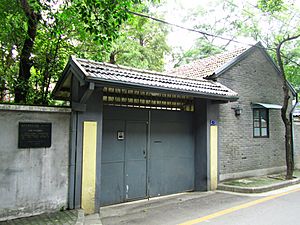
Bai Chongxi and his wife had ten children. They had three girls and seven boys. His son, Kenneth Hsien-yung Pai, became a famous Chinese author.
His Legacy
Bai Chongxi was known as a brilliant military strategist. An American Marine Corps colonel, Evans Carlson, called him "the keenest of Chinese military men." Another writer, Edgar Snow, said he was "one of the most intelligent and efficient commanders boasted by any army in the world." His skills and leadership were highly respected.
See also
 In Spanish: Bai Chongxi para niños
In Spanish: Bai Chongxi para niños
- Islam in China
- Islam in Taiwan




